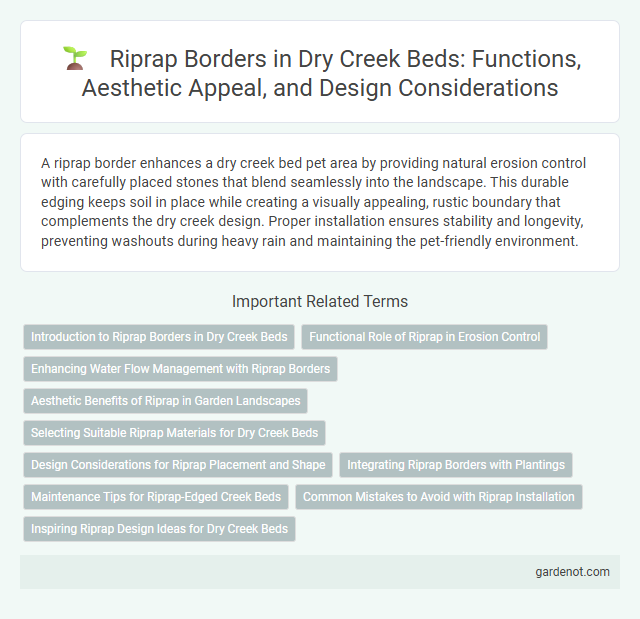A riprap border enhances a dry creek bed pet area by providing natural erosion control with carefully placed stones that blend seamlessly into the landscape. This durable edging keeps soil in place while creating a visually appealing, rustic boundary that complements the dry creek design. Proper installation ensures stability and longevity, preventing washouts during heavy rain and maintaining the pet-friendly environment.
Introduction to Riprap Borders in Dry Creek Beds
Riprap borders in dry creek beds consist of strategically placed large stones or rocks that prevent soil erosion and enhance water flow management. These durable materials stabilize the creek bed edges, reducing the impact of runoff and stormwater. Incorporating riprap borders protects the surrounding landscape while promoting natural drainage patterns.
Functional Role of Riprap in Erosion Control
Riprap borders serve as a critical erosion control measure by stabilizing the banks of a dry creek bed and preventing soil displacement caused by water flow. Composed of large, angular stones, riprap dissipates the energy of runoff and reduces the velocity of water, minimizing the impact on vulnerable soil surfaces. This structural barrier enhances creek stability, controls sediment movement, and preserves the natural landscape integrity.
Enhancing Water Flow Management with Riprap Borders
Riprap borders stabilize dry creek beds by preventing soil erosion and directing water flow effectively during rainfall. These stone linings absorb and dissipate the energy of moving water, reducing sediment displacement and minimizing flooding risks. Properly engineered riprap borders enhance water flow management while preserving the natural ecosystem of the creek bed.
Aesthetic Benefits of Riprap in Garden Landscapes
Riprap borders enhance garden landscapes by providing a natural and rugged aesthetic that complements dry creek beds with textured stone arrangements. The varied sizes, colors, and shapes of riprap create visual interest and contrast against surrounding greenery, improving the overall design appeal. This durable material also frames the dry creek effectively, reinforcing a balanced and harmonious outdoor environment.
Selecting Suitable Riprap Materials for Dry Creek Beds
Selecting suitable riprap materials for dry creek beds requires considering durability, size, and texture to ensure effective erosion control and water flow management. Opt for angular, locally sourced stones with a mix of sizes ranging from 4 to 12 inches, promoting interlocking stability and reducing displacement during heavy flow. Properly sized riprap enhances the dry creek bed's structural integrity while blending naturally with the surrounding landscape.
Design Considerations for Riprap Placement and Shape
Riprap placement in dry creek beds requires careful consideration of stone size, shape, and arrangement to ensure erosion control and structural stability. Angular, well-graded rocks with rough surfaces interlock effectively, reducing displacement during high flow events. Proper slope alignment and layering techniques enhance hydraulic performance and shore protection.
Integrating Riprap Borders with Plantings
Riprap borders effectively stabilize dry creek beds by preventing erosion and directing water flow while offering a natural aesthetic. Integrating native plants between the riprap enhances soil retention, promotes biodiversity, and softens the hardscape appearance. Selecting drought-tolerant species such as sedges, ornamental grasses, and succulents ensures sustainable growth alongside the stone border.
Maintenance Tips for Riprap-Edged Creek Beds
Regular inspection of riprap borders in dry creek beds prevents displacement and erosion by identifying loose or missing stones early. Clearing debris and vegetation from between rocks maintains proper water flow and reduces the risk of blockages that can compromise the riprap structure. Applying fresh gravel or stone periodically helps reinforce the border's stability and extends the lifespan of the creek bed's erosion control system.
Common Mistakes to Avoid with Riprap Installation
Common mistakes to avoid with riprap installation in a dry creek bed include using improperly sized stones, which can lead to erosion and instability, and neglecting proper layering and compaction, reducing the effectiveness of the riprap barrier. Failing to install adequate underdrain systems or geotextile fabric can cause soil erosion beneath the riprap, compromising the structural integrity. Ensuring consistent stone placement and avoiding gaps will maintain durability and prevent water from washing away underlying materials.
Inspiring Riprap Design Ideas for Dry Creek Beds
A riprap border enhances dry creek beds by using strategically placed stones to prevent erosion and add natural texture. Incorporate varying sizes and colors of rocks to create visual interest and complement surrounding landscaping. Integrating native plants among the riprap softens edges while promoting habitat diversity and sustainable drainage.
Riprap border Infographic

 gardenot.com
gardenot.com